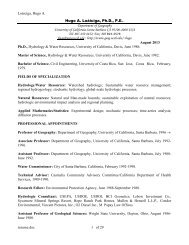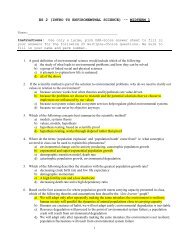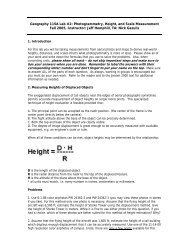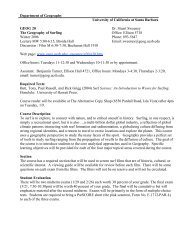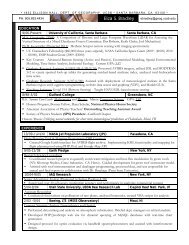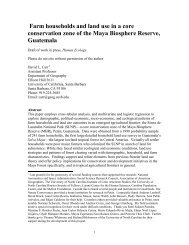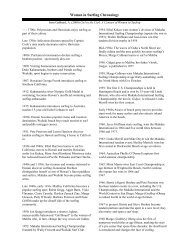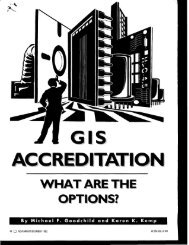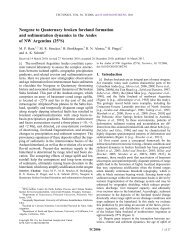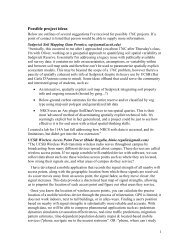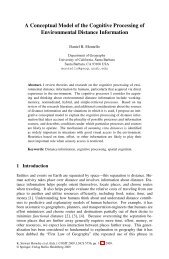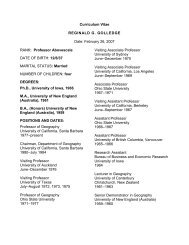Spatial knowledge acquisition from direct experience in the ...
Spatial knowledge acquisition from direct experience in the ...
Spatial knowledge acquisition from direct experience in the ...
You also want an ePaper? Increase the reach of your titles
YUMPU automatically turns print PDFs into web optimized ePapers that Google loves.
120 T. Ishikawa, D.R. Montello / Cognitive Psychology 52 (2006) 93–129<br />
of spatial learn<strong>in</strong>g. The average participant can do that, to some degree, after Wrst be<strong>in</strong>g<br />
exposed to <strong>the</strong> connect<strong>in</strong>g-route. Mean po<strong>in</strong>t<strong>in</strong>g error between landmarks on <strong>the</strong> two<br />
routes is signiWcantly better than chance performance and guess<strong>in</strong>g performance. In contrast,<br />
mean distance correlation is not signiWcantly better than chance or guess<strong>in</strong>g.<br />
The sketch maps drawn after Session 4 correlate a robust and signiWcant .82 with <strong>the</strong><br />
actual layout of <strong>the</strong> two routes. As discussed <strong>in</strong> Section 4.3 on simulated sketch mapp<strong>in</strong>g, it<br />
is important to note that bidimensional correlations based on random conWgurations of<br />
po<strong>in</strong>ts are still well above 0 (as high as .4). Also, bidimensional correlations reXect <strong>direct</strong>ion<br />
as well as distance <strong>in</strong>formation; thus, <strong>the</strong> small distance correlation is not necessarily<br />
<strong>in</strong>consistent with <strong>the</strong> high bidimensional correlation. Participant P18’s map (shown <strong>in</strong><br />
Appendix A), for <strong>in</strong>stance, depicts <strong>the</strong> conWguration of <strong>the</strong> two routes only roughly,<br />
although it correlates .79 with <strong>the</strong> actual layout.<br />
5.2.2. F<strong>in</strong>al exposure and developmental trends<br />
Compared to with<strong>in</strong>-route tasks, performance on between-route tasks shows more<br />
improvement over <strong>the</strong> course of <strong>the</strong> study, even though it is based on only seven sessions.<br />
After <strong>the</strong> Wnal of <strong>the</strong> 10 sessions, we Wnd that participants understood <strong>the</strong> layout<br />
of <strong>the</strong> <strong>in</strong>tegrated routes quite a bit better than after <strong>the</strong> Wrst session of exposure to <strong>the</strong><br />
connect<strong>in</strong>g-route. Both mean po<strong>in</strong>t<strong>in</strong>g error and mean distance correlation between<br />
landmarks on <strong>the</strong> two routes are signiWcantly better than chance performance, guess<strong>in</strong>g<br />
performance, and performance after Wrst exposure. These improvements over <strong>the</strong><br />
course of <strong>the</strong> study are reXected <strong>in</strong> signiWcant l<strong>in</strong>ear trends <strong>in</strong> <strong>direct</strong>ion and distance<br />
estimates for <strong>the</strong> <strong>in</strong>tegrated routes. Sketch maps drawn after <strong>the</strong> Wnal session are bidimensionally<br />
correlated .88. The l<strong>in</strong>ear and quadratic trends <strong>in</strong> bidimensional correlations<br />
were statistically signiWcant, show<strong>in</strong>g that <strong>the</strong> sketch-map accuracy <strong>in</strong>creased Wrst<br />
and <strong>the</strong>n leveled oV.<br />
5.2.3. Simulations<br />
Results <strong>from</strong> <strong>the</strong> between-route <strong>direct</strong>ion and sketch-mapp<strong>in</strong>g simulations show that<br />
participants know more than <strong>the</strong> identities of landmarks and <strong>the</strong> general relationship of<br />
which route was on which side (left or right). In contrast, participants’ <strong>knowledge</strong> of <strong>direct</strong><br />
distances between landmarks on <strong>the</strong> two routes does not even reach <strong>the</strong> categorical level, <strong>in</strong><br />
both <strong>in</strong>itial and Wnal sessions.<br />
We can conclude that <strong>the</strong> average participant was somewhat able to <strong>in</strong>tegrate <strong>the</strong> two<br />
separately learned routes after a s<strong>in</strong>gle drive along <strong>the</strong> connect<strong>in</strong>g-route, although this was<br />
clearly a challeng<strong>in</strong>g task that was not performed very well. In particular, <strong>the</strong> <strong>in</strong>tegration<br />
<strong>experience</strong> that we gave to participants allowed <strong>the</strong>m to approximately orient <strong>the</strong>ir representations<br />
of <strong>the</strong> two routes to each o<strong>the</strong>r, but it allowed almost no scal<strong>in</strong>g of <strong>the</strong> straightl<strong>in</strong>e<br />
distances between <strong>the</strong> two.<br />
5.3. Individual diVerences: Aggregate versus <strong>in</strong>dividual data<br />
The analyses of mean performance aggregated over <strong>the</strong> 24 participants enable us to<br />
discuss <strong>the</strong> nature of people’s metric spatial <strong>knowledge</strong>. In particular, very little developmental<br />
change is observed across <strong>the</strong> 10 weeks of <strong>the</strong> study—mean performance is ei<strong>the</strong>r<br />
very good right <strong>from</strong> <strong>the</strong> beg<strong>in</strong>n<strong>in</strong>g (e.g., route-distance estimates) or mediocre without<br />
much improvement (e.g., <strong>direct</strong>ion estimates on <strong>the</strong> U-route). These results might lead us



